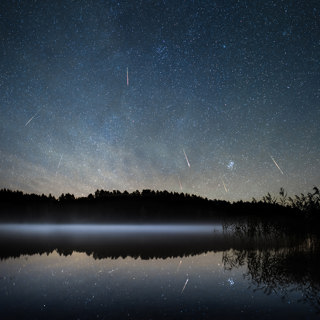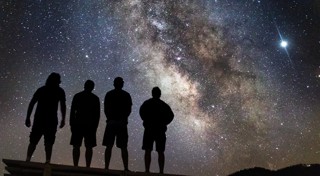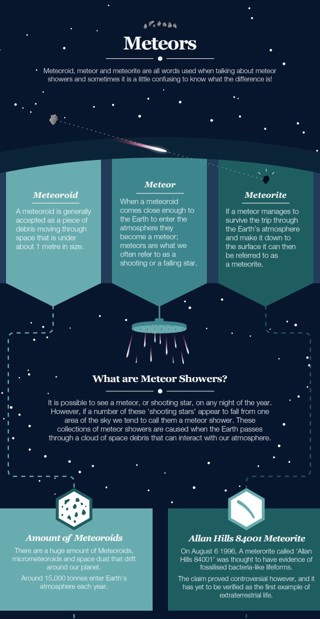
Perseid Meteor Shower 2024
- 29th Jul 2024
- Author: Lucy Spencer
Perseids
The Perseid meteor shower is one of most prolific showers of the year with around 100 meteors per hour at its peak, in perfect conditions. This year, it is active between 17 July and 24 August, with the peak falling on the night of 12 August into 13 August.
The radiant of this meteor shower appears to come from the constellation of Perseus which is a circumpolar constellation as seen from the UK, so it can always be seen above the horizon. Meteors should become visible soon after the Sun sets, however the best time to view the Perseids is when the night sky is darkest at around midnight and into the very early hours of the following morning.
What is a Meteor Shower?
Meteor showers occur when the Earth passes through the debris of a comet. The dust and gas left behind by the comet burns up in the atmosphere causing a shooting star. The Perseids come from the comet 109P/Swift-Tuttle. Every year between July and August, the Earth crosses the orbital path of the comet which has been littered with dust left behind on previous passes. As the Earth hurtles through this region, the debris hits the Earth’s atmosphere at more than 200,000 kilometres an hour, causing it to burn up and appear as a streak of light across the sky.
The average speed for a Perseid meteor is 36 miles per second (that’s 129,600 miles per hour!). Smaller meteors vaporise in the atmosphere and leave behind a bright trail, but larger meteors can explode as fireballs (a meteor that appears brighter than any of the planets).
Comet Swift-Tuttle takes around 130 years to orbit the Sun with the first record of the Perseids dating back to 36 AD! The comet last approached Earth in 1992 and will next be visible from Earth in 2126. The comet will be easily visible with the naked eye, but that will be for future generations to enjoy.
How to Watch from the UK
To view the Perseids from the UK, head out on the night of 12 August and before dawn on 13 August. Even though the radiant of the Perseids comes from the constellation Perseus, you can look at the whole sky, though it may be helpful to stand facing northeast towards Perseus. You should be able to see a couple of meteors a minute in ideal conditions at the peak, so let’s hope for clear skies!
On 12/13 August the Moon sets around 23:00 so there will be no moonlight pollution during the peak! Therefore the best time to view the Perseids will be when it gets dark around midnight into the very early hours of the morning.
There are also other astronomical objects to spot around this time. Jupiter and Mars rise after midnight in the east, directly below the constellation Perseus, so if you have binoculars or a telescope you may be able to see Jupiter’s Galilean moons and Mars' rusty red disk! The Pleiades or the Seven Sisters is an open cluster of stars slightly above and to the right of Jupiter which you will be able to see with the naked eye, but you can see more detail through binoculars or a telescope. Furthermore, if you look above and slightly to the right of Perseus, you may be able to see a faint smudge - this is the Andromeda Galaxy! Finally looking south, you will also be able to spot Saturn in the constellation of Aquarius.
So, find a dark sky area, wrap up warm, and allow at least 20 minutes for your eyes to adjust to the low light conditions, and then scan the skies to enjoy the shooting stars using just the optical tool nature gave you – your eyes!
To find your nearest dark sky site use Go Stargazing.
Meteor Infographic
Download our National Space Centre Meteor Shower Guide to make sure you are fully prepared!
Stay tuned in 2024 for upcoming meteor showers:
Draconids
Comet of Origin: 21P/Giacobini-Zinner
Radiant: constellation Draco
Peak Activity: 8-9 October 2024
Peak Activity Meteor Count: up to 10 meteors per hour (In rare instances, fiery Draco has been known to spew forth many hundreds of meteors in a single hour.)
Orionids
Comet of Origin: 1P/Halley
Radiant: constellation Orion
Peak Activity: 21-22 October 2024
Peak Activity Meteor Count: up to 20 meteors per hour
Northern Taurids
Comet of Origin: 2004 TG10
Radiant: constellation Taurus
Peak Activity: 11-12 November 2024
Peak Activity Meteor Count: 5 meteors per hour
Leonids
Comet of Origin: 55P/Tempel-Tuttle
Radiant: constellation Leo
Peak Activity: 16-17 November 2024
Peak Activity Meteor Count: up to 10 meteors per hour
Geminids
Asteroid of Origin: 3200 Phaethon
Radiant: constellation Gemini
Peak Activity: 13-14 December 2024
Peak Activity Meteor Count: up to 150 meteors per hour
Ursids
Comet of Origin: 8P/Tuttle
Radiant: constellation Ursa Minor
Peak Activity: 21-22 December 2024
Peak Activity Meteor Count: up to 10 meteors per hour
Happy meteor-gazing!
Full references / credits:
(Banner image) Meteor showers. Credit: © National Space Centre
(1) Perseids meteors, 2016. Credit: Arnas Goldberg CC BY 3.0 DEED https://commons.wikimedia.org/wiki/File:Perseids_2016_(167839765).jpeg
(2a) Radiant of Perseid meteor shower. Credit: Stellarium
(2b) Group of people stargazing. Credit: Kendall Hoopes (public domain) https://www.pexels.com/photo/silhouette-of-people-stargazing-2901134/
(3) Meteors infographic. Credit: © National Space Centre





